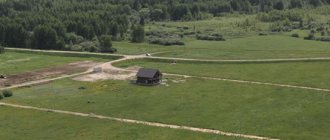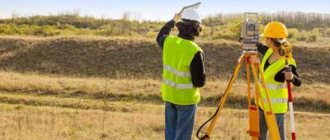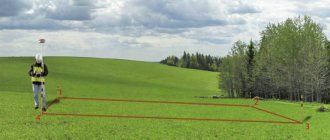The legal capacity of land owners depends on the results of boundary surveying with land plots located in the neighborhood .
It is also very important for owners of neighboring plots to clearly define and secure boundaries.
Therefore, their presence during land surveying and their expression of their opinions are an important condition for the correct and legal conduct of the land surveying procedure.
When approval is needed
One of the stages of the process of land surveying is the coordination of its boundaries with adjacent landowners. This is the most difficult moment, which causes many conflicts and litigation.
Let's look at how to properly survey a plot of land with neighbors and what documents will be required from them.
Agreeing on the location of boundaries is required if the neighboring area :
- relates to the personal property of its owner;
- belongs by right of lifelong inheritable ownership;
- is in constant perpetual use;
- leased from the state or municipality.
This is regulated by Part 3 of Article 39 of Federal Law No. 221 “On the State Real Estate Cadastre”. A neighbor participating in the determination of boundaries has the right to raise objections only along his own border.
Obtaining approval occurs only free of charge .
How to challenge a neighbor's land survey
The placement of a private house and the definition of neighbors' boundaries becomes a frequent subject of dispute. Owners can express their disagreement with the resulting measurement result. Particularly suspicious people always think that they will definitely be deprived of the established markings and their rightful property will be taken away. A conflict also arises if the owners of neighboring plots are not notified of the very fact of land surveying.
An analysis of judicial practice has shown that a neighbor who has seized part of a land plot that did not previously belong to him may face real punishment in the form of a fine. In the case of squatting, subject to bona fide ownership and the absence of disputes or claims from other citizens for 15 years, no fine will be collected. In this case, for example, driving through an unfenced neighbor's garden will not be punishable.
In order to resolve a boundary dispute, you must first use pre-trial settlement of the issue. This path is considered peaceful and easiest. If it is not possible to reach an amicable agreement, then you will have to resort to a judicial solution to the issue. Pre-trial regulation will be expressed in the following actions:
- contact the engineer who provided the survey service and point out errors and inaccuracies in his work;
- collect documentation that can confirm the existence of an error;
- write an application with a request to correct the discrepancy and, with the documents attached to it, submit it to the cadastre chamber;
- wait for a response after 15 days.
The question of how to challenge the land surveying of a neighbor’s land can only be resolved in one way. It is possible to challenge the boundaries of a site only if the result of the survey is invalid. Only interested persons can exercise the right to cancel such a document. First of all, these are the owners. Ownership of a plot can be confirmed by the following documents:
- plot lease agreement;
- agreement for receiving an allotment for unlimited use;
- act of privatization;
- certificate of perpetual inheritable ownership.
Attention! If there are compelling reasons and their documentary confirmation by the cadastral chamber, changes will be made to the current plan. This procedure for solving the problem will be considered administrative.
The trial goes through more stages. In addition, it should be remembered that if at the last moment, due to oral agreements with the owner of the disputed plot, you abandon your claims, then it will no longer be possible to go to court again on the same issue.
The court will also take into account the standards for the construction and location of neighbors' houses. Said proceedings will include the following:
- drawing up a statement of claim;
- supporting the application with the necessary documents confirming the plaintiff’s case;
- payment of state fees;
- notification of the defendant (carried out by a judicial authority);
- consideration of the dispute during civil proceedings (it is possible to hold several hearings and postpone hearings at the request of the parties for additional collection of information or requests from the court);
- making a decision on the case;
- appealing the verdict (10 days will be allotted, after this period the verdict will be considered to have entered into legal force);
- receiving the verdict in your hands.
Important! A court decision will make it possible to force changes in the boundary matter. To do this, you need to submit it to the cadastral chamber and write a corresponding application. Only by such a decision will neighbors be prohibited from entering private territory.
The following documents will serve as the evidence base for resolving the issue of errors in land surveying:
- documents confirming the rights to the disputed plot (title);
- a diagram showing the location of the disputed plot, as well as the areas bordering it;
- consent of neighbors, documented in writing, or their refusal;
- documents confirming attempts to peacefully resolve the issue (letters to neighbors, applications to the cadastral chamber);
- publication in the media about land surveying or lack thereof.
The judicial authority for filing a claim will depend on the status of the parties involved in the dispute. If both participants are individuals, then the application must be submitted to a court of general jurisdiction. If there is a legal entity as a participant in the process - to the arbitration court.
Rosreestr compulsorily changes information only by court decision. The resolution should be submitted together with the boundary plan, which was considered correct in court. Cancellation of land surveying by a court decision is available only to the owner of the disputed plot, but also to his neighbors if they believe that their interests have been infringed. Registration of a neighboring abandoned plot is possible after contacting the local administration.
Notification of neighboring property owners
Once the approximate day for the survey has been set, it is required to notify all owners of land plots bordering the given one .
The law sets a time limit for notification: it must be sent no later than 30 days before the expected day of approval.
You can notify your neighbors in several alternative ways:
- Notify by registered letters with notifications . The places of residence of neighbors can be found out in the cadastral service. It is advisable to use this type of notification when there is confidence that the citizen will not sign the notice, and therefore the act of approval. Therefore, it is advisable to send three letters to the neighbor, since a letter sent three times in the name of one person becomes a basis for believing that the signature of this person received.
- Personally deliver the notices to each of the recipients, receiving his signature. If there is no signature, it will be impossible to prove that the neighbor was not served with a notice.
- Send an email (with a read receipt). This type of notification is the least popular, since not everyone has an email and email addresses are not publicly available.
- Publish an ad in the local press . This is usually practiced if the place of residence of a neighbor cannot be determined, or when delineating plots located within a gardening and dacha partnership.
A notice sent to a neighbor can be written in free form (a sample can be viewed and downloaded via the link), but it must include the following information :
- The notification begins with an address to this specific citizen indicating his full name.
- Next, enter the full name of the person requesting the procedure, his address and telephone number for contacts.
- The data of the cadastral engineer, his full name, address, telephone number are recorded.
- The address of the actual location of the site and its cadastral data are indicated. If there is no address yet, the block where the site is located is indicated.
Information about adjacent areas is included, with addresses and exact numbers. At the end, the time and place of the planned coordination and ways to obtain information about the procedure being carried out are indicated.
Grounds for cancellation
There are legal grounds that allow you to cancel the legal force of a drafted act. Here it is worth considering the most common reasons:
- The neighbor is sure that his rights to own the land have been violated. In other words, the established boundaries reduced the area of his own property.
- It turned out that the document was signed by a person who is not the owner of the neighboring territory. He does not have such a right, so the act can be appealed and demand its cancellation.
- The neighbor suspects that the cadastral service employee made a mistake. And it doesn’t matter whether it was done intentionally or by accident. An incorrectly established boundary is a good reason for canceling the legal force of a document.
In all of the above situations, it is recommended to go to court. Naturally, you will need to present all available documents that will allow you to prove that the act was indeed drawn up incorrectly. The statement of claim should indicate the possible reasons for the incorrect determination of boundaries. By the way, it is recommended to go to court in situations where a neighbor refuses to sign a document without any explanation.
Under certain circumstances, you can do without neighbors. For example, if a neighboring plot is leased for a short term, the tenant cannot sign such a document. In some circumstances, a signature can be replaced by a document. For example, when the owner has lost the right to the land, and the new person has not yet managed to obtain rights to it. This is permitted in cases where the owner:
- seriously ill;
- declared incompetent;
- is in a correctional colony;
- died;
- declared missing without a trace.
In this case, the heir must submit a document confirming the fact that the owner is not able to personally sign the document. In general, you can do without approval in other situations:
- the site is adjacent to the state border;
- the area is surrounded by forest or river;
- there is a cliff, rocks or other natural obstacles along the edge;
- The land plot is surrounded by abandoned territory.
Validity period of the act
The law does not define a clear validity period for this document. It can be concluded that the act will be in force until this process needs to be repeated. The act is sent to the cadastral archive for storage. The owner of the territory can request it if necessary.
As for the approval itself, there are certain deadlines. As mentioned above, neighbors must be notified a month before the procedure for determining boundaries. Thus, the preparation period cannot be less than 30 days. Often this period takes one and a half months. You also need to take into account that if the cadastral company experiences a large influx of clients, you will have to wait your turn, and accordingly, the procedure may take a longer time.
How does the procedure work?
The law allows for approval to be carried out separately with each of the owners or joint approval by convening a meeting of neighbors.
The collective method is more preferable, since it is possible to jointly review previously prepared cadastral and boundary plans, evaluate the boundaries and discuss them.
All explanations are made by the cadastral specialist, who also fills out the approval document, which must be signed by all participants.
The specialist must:
- Personally check the passports of those present, and, if necessary, verify the presence of a notarized power of attorney.
- Provide all interested parties with documents, diagrams and plans, and explain the details.
- Show the location of plot boundaries on the ground.
If the prepared documents do not raise any objections or complaints, then the approval is considered received and an act of approval of the boundaries of the land plot is drawn up.
Invalid survey without signature
In certain situations, the signature of neighbors is necessary in order for the boundary plan to still have legal force and the passing border of the land plot to be recognized as valid.
The cases where a boundary plan cannot be recognized as valid without a neighbor’s signature are as follows:
- The neighbor's attendance at the meeting. At the same time, he expresses his disagreement with the passing boundary and, as a consequence, the boundary plan cannot be considered valid without eliminating the reasons for such disagreement;
- The neighbor sent an official letter in which he informed about certain requirements regarding the boundaries (in fact, disagreement with the way the cadastral engineer sees the location of the boundaries). In such a situation, there should also be an elimination of inaccuracies, an attempt to still come to an agreement with a neighbor or, as a last resort, go to court to protect one’s rights;
- There were no procedures in place to properly notify stakeholders. That is, even if there was information about the neighbor’s location, a notification was not sent to him.
A similar situation also applies if the neighbor’s residential address is unknown and an announcement about the meeting has not been published in the local media.
In this case, the neighbor has the legal right to subsequently protest the results of the land survey and the court will most likely be on his side.
Signing of the final act
An act of approval is a document by signing which all adjacent land users express their agreement or disagreement with the establishment of boundaries .
Boundaries are considered as agreed upon if the act is certified by the personal signatures of all landowners, and in the absence of owners there are objections written by them.
Acts are drawn up according to established rules , violation of which makes the document invalid:
- The act is signed by all owners of adjacent plots or their legal representatives.
- All information entered in the act must be truthful and correspond to the data from the cadastral plan and other documents.
- If disagreements arise during the discussion, they are documented in writing in a separate document and filed with the act.
Any disagreements that arise are resolved according to the terms of the Land Code of the Russian Federation . If this is not possible, the situation will need to be resolved through the courts.
The act indicates the full names of all adjacent landowners, their opinions on the boundaries of the site, and also inserts diagrams and drawings of the sites.
Parties
At the stage of determining the size of the allotment, fixing them in text and graphic form, as well as approving the act, the following parties can participate:
- the customer of boundary work is the legal holder of the allotment;
- an engineer whose powers include carrying out work on preparing a boundary plan and drawing up the necessary documentation;
- owners of neighboring plots of land that have a common line with the surveyed plot;
- officials of Rosreestr, if, on their initiative, the boundary plan is aimed at finalization and coordination with neighbors.
The owners of the plots are directly involved in the preparation of such a document, and they are obliged to sign it or submit objections. Coordination is carried out in two possible options - at a general meeting of all interested parties or by reviewing the act in absentia.
Clarification of boundaries without the consent of neighbors
Many people are interested in the question: is it necessary to have the consent of neighbors when carrying out land surveying of their property? The law provides for cases when it is possible to carry out approvals without involving neighbors.
Such cases include:
- All adjacent landowners have already carried out land surveying of their plots , the boundaries have been documented and in fact, the interests of the customer of these cadastral works have not been affected. The cadastral engineer must obtain all the data on these plots and note this in his documents. The plot is simply “tied” to the already registered boundaries of adjacent plots.
- It is impossible to establish the exact place of residence of the neighbor , the site has long been abandoned, no one is looking after it, his address and contact details are unknown to anyone. In such cases, advertisements are published in newspapers. If the owner of the site does not make himself known within a month, the approval is considered to be carried out by default.
- The owner does not appear at the appointed time , despite the fact that he was notified by letter or in person. There were no written objections or justifications for his reluctance to participate. Therefore, the approval is considered as received, the corresponding entry is entered into the act, and the boundary plan is supplemented with the necessary documents.
Please keep in mind for the future that if this neighbor provides evidence that his failure to appear is valid (illness, missed notice, stay abroad), he has the right to seek a review of the approved boundaries through the court.
When a written refusal indicating the grounds for absence is received within a month after notification , this document is also filed with the approval act, and a special note about this is made in the text.
Objections do not prevent full use of the site , but future disputes are possible, and the buyer will need to be notified of this upon sale.
Objections
The possibility of filing an objection is a guarantee that the interests of interested parties are respected. Objections may be made on the following grounds:
- intersection or overlap of previously defined edges of adjacent areas;
- reduction in the area of neighboring plots by more than 5%;
- unreliable determination of the coordinates of characteristic points of the boundaries of the surveyed area, which violates the interests of other rights holders;
- discrepancy between the established boundaries and previously registered information and rights to real estate in the Unified State Register of Real Estate.
Objections are made in writing, and the cadastral engineer is obliged to include them in the contents of the act in an unchanged form.
When sending a repeated approval act, interested parties can also file objections, which will later be considered in court.
The law provides for restrictions on drawing up an approval act and filing objections - this procedure is not required for agricultural land; for lands under linear objects and communication lines, as well as in some other cases. If, during the surveying of these objects, violations were committed by the owners of neighboring land plots, they have the right to present their objections in court when challenging the cadastral registration results.
When is it possible to set boundaries without agreement?
If the boundaries of the site do not pass through the sites included in the Unified State Register of Real Estate, they are not required to be approved by law.
It is necessary to coordinate only those areas that simultaneously serve as boundaries between neighboring areas (Article 39 of Federal Law No. 221 “On Cadastral Activities” as amended on July 3, 2016). That is, if the site borders on vacant land or faces the street, there is no need for approval.
No approvals are required if this land plot is adjacent to :
- forest area;
- a specially protected area (for example, the borders of a country);
- agricultural lands in the Far North, Far East and Siberia;
What to do if it is not possible to find the owners
If, during the preparation of the draft boundary plan, immediate neighbors could not be found, the owner of the site, in order to ensure that it is impossible to challenge the drawn up boundary plan, must strictly follow the requirements of legislative acts.
That is, in cases where the whereabouts of the neighbor are not known, it is necessary to comply with the existing procedure for notification in such cases - the original of the media in which the notification was published is attached to the boundary file as evidence of compliance with the required procedure .
Cadastral errors
When establishing the boundaries of a plot, errors occur, most of which fall under the responsibility of the cadastral specialist . It is he who is responsible for the correctness and legality of the procedure.
The most common mistakes when surveying:
- Carrying out cadastral work led to a violation of the rights and interests of the owners of other plots, namely, a certain part of their territory was seized.
- The agreement was not carried out or was carried out in violation of the laws. For example, neighbors were notified late or were given incorrect information.
- The act was drawn up in violation of the law and contains errors . For example, the required signatures do not belong to the real owners of the plots or their signatures are forged.
Strict sanctions apply to the cadastral engineer . For example, repeated violations lead to the fact that he is deprived of his license and the right to work in this field.











